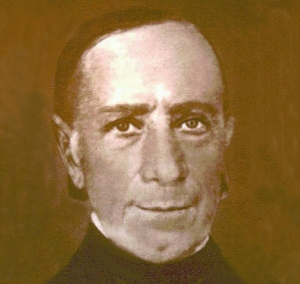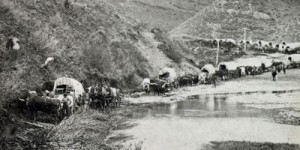William Young Black (1784-1873) and Family Crossing the Western Plains
 William Young Black, son of William Black and Mary Gardiner,was born on 20 Aug 1784 in Lisburn, Antrim, Ireland, died on 28 Jan 1873 in Rockville, Washington, Utah, United States at age 89, and was buried in Rockville, Washington, Utah, United States. William married Jane Johnston on 31 Jul 1822 in Lisburn, Antrim, Ireland. William Black died January 28, 1873, at Rockville, Kane County, Utah. He was a man of unassuming character, strictly honest and much loved by all his acquaintances, and he died firm in the faith which is known as the Mormon doctrine.
William Young Black, son of William Black and Mary Gardiner,was born on 20 Aug 1784 in Lisburn, Antrim, Ireland, died on 28 Jan 1873 in Rockville, Washington, Utah, United States at age 89, and was buried in Rockville, Washington, Utah, United States. William married Jane Johnston on 31 Jul 1822 in Lisburn, Antrim, Ireland. William Black died January 28, 1873, at Rockville, Kane County, Utah. He was a man of unassuming character, strictly honest and much loved by all his acquaintances, and he died firm in the faith which is known as the Mormon doctrine.
William moved to Nauvoo in the fall of 1844 and lived there until the expulsion of the Saints. Then moved into Kanesville Iowa, where the family spent the next three years.
On June 12, 1850, the Captain James Pace Company, consisting of 100 wagons, left Kanesville, now known as Council Bluffs for the trek overland to Salt Lake City. William Y., Jane, William V., age 18, Joseph S., age 14, Johnson McDonald, age 4, and Mary Ann Donelley, along with her baby girl, made up the family.
Wagons going to Oregon, California, and Utah shared the same trail until they reached the continental divide at South Pass Wyoming. The trip from Wyoming, Nebraska to Salt Lake City Utah was 1,100 miles.
South Pass Wyoming is perhaps the most significant transportation-gateway through the Rocky Mountains. Indians, mountain men, Oregon Trail emigrants, Pony Express riders, and miners all recognized the value of this passageway straddling the Continental Divide. Bounded by the Wind River Range on the north and the Antilope Hills on the south, the pass offered overland travelers a broad, relatively level corridor between the Atlantic and Pacific watersheds.
 At South Pass the trail separates and is called “The parting of the ways.” Parting of the Ways marked the point where parties headed to California and those headed to Oregon parted ways. In fact, if your destination was either California or Oregon, either branch would serve you well. Those in need of supplies or worried about the condition of their members or livestock usually took the left fork, towards Fort Bridger. Since this was also the only route to Utah, Mormon parties always took the road to the left. But California-bound emigrants could and often did travel with their Oregon-bound friends as far as the middle of Idaho. Nonetheless, Parting of the Ways did mark a spot where many emigrants bid a tearful farewell to friends they would probably never see again.
At South Pass the trail separates and is called “The parting of the ways.” Parting of the Ways marked the point where parties headed to California and those headed to Oregon parted ways. In fact, if your destination was either California or Oregon, either branch would serve you well. Those in need of supplies or worried about the condition of their members or livestock usually took the left fork, towards Fort Bridger. Since this was also the only route to Utah, Mormon parties always took the road to the left. But California-bound emigrants could and often did travel with their Oregon-bound friends as far as the middle of Idaho. Nonetheless, Parting of the Ways did mark a spot where many emigrants bid a tearful farewell to friends they would probably never see again.
The transcontinental railroad reached Utah May 10, 1869, and from that time on emigrants could ride the rails all the way to Zion. From these two railheads, at Laramie and Benton, Mormon emigrants would have picked up the Overland-Bridger Pass Trail, followed it to Fort Bridger and then taken the Mormon Trail into Utah.
In the fall of 1861, I moved to southern Utah on the Rio Virgin River, remaining there until 1873. During this time, records show that William Black and Jane Johnston Black resided along the banks of the Rio Virgin River in a location which is now known as SpringdaIle, Utah, which is the entrance to the present day Zions National Park. William Black died January 28, 1873, at Rockville, Kane County, Utah.
He was a man of unassuming character, strictly honest and much loved by all his acquaintances, and he died firm in the faith which is known as Mormon doctrine. Excerpts from biographical sketch of William Young Black, by Henry J. Black, Manti, Utah. Annotated to reflect additional information.

/-6.0374,54.5097,12/300x200@2x.png?access_token=pk.eyJ1IjoiamJlcmdlbiIsImEiOiJjanRxb3d1NWgwaHBuM3lvMzJ3emtyNWY4In0.xCCZGVjZrBAKn5C_O6q8CA)
/-113.0383,37.1611,12/300x200@2x.png?access_token=pk.eyJ1IjoiamJlcmdlbiIsImEiOiJjanRxb3d1NWgwaHBuM3lvMzJ3emtyNWY4In0.xCCZGVjZrBAKn5C_O6q8CA)